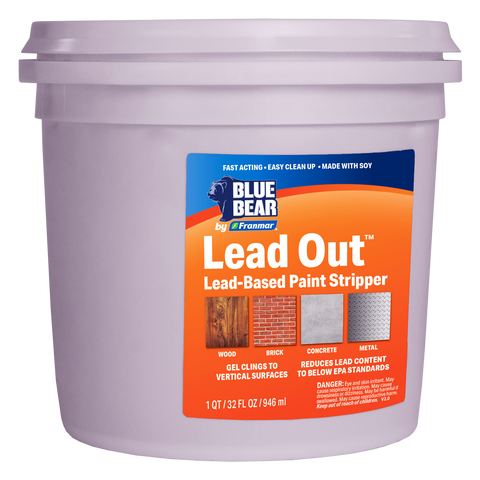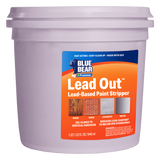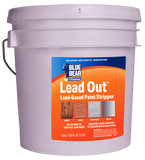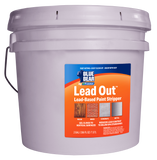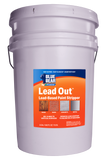BLUE BEAR® Lead Out™ Lead-Based Paint Stripper
Temporarily Unavailable
Recommended alternatives: Soy Gel and Safenol work by encapsulating lead, which prevents airborne particles and allows it to be disposed of safely. Please contact our customer service representatives at 800-538-5069 with any questions.
Take the hazards out of lead paint removal and disposal with BLUE BEAR® Lead Out™ Lead Based Paint Stripper. Our easy-to-use kit combines a soy-based paint stripper with our patented Molecular Bonding System (MBS®) that, when applied, changes lead into a non-hazardous compound. Our lead-based paint removal system is a simple and affordable option that’s been used by Fortune 500 companies including General Motors, Duke Energy and Lockheed Martin and government agencies including the U.S. Army Corps of Engineers, U.S. Bureau of Reclamation and U.S. Navy. Ideal for home and furniture renovations!
- Works on wood, brick, concrete and metal surfaces
- One gallon covers approximately 100 square feet on a horizontal surface or 50 square feet on a vertical surface
- Biodegradable and non-caustic
- Made with 100% American-grown soybeans
Watch how Lead Out and Soy Gel work on lead paint!
DIRECTIONS:
MIXING: Wearing the provided mask and gloves, and using a stir stick, mix Lead Stabilizing Powder package thoroughly with paint stripper. Once mixed, the product will only work to convert lead particles in the paint for 24 hours.
APPLICATION: Apply a medium to thick layer on the surface using a brush or similar tool. Key to success is to apply thick enough. Applying too thin will cause the stripper to dry out before removal is complete. Use a scraper to check if the coating is softened down to the surface. When the coating is completely softened, remove with scraper. Collect the converted lead coating(s) in a suitable container for disposal.
CLEAN UP: Use BLUE BEAR® Emerge™ Cleaner & Degreaser or water and a scrub brush, mop or power washer to clean remaining residue. Remove excess coating(s) and gelled stripper before using a power washer for final cleaning. Allow surface to dry before further preparations.
DISPOSAL: Dispose of in accordance with local, state and federal regulations.
What Our Customers Say:
“Works well.” - Jennifer, Eco-buildingProducts.com

WARNING: This product can expose you to chemicals including n-methyl-2-pyrrolidone, which is known to the state of California to cause birth defects or other reproductive harm. For more information, go to www.P65Warnings.ca.gov
FREQUENTLY ASKED QUESTIONS:
How do I know if I have lead paint?
Renovation, repair and painting activities may disturb painted surfaces and produce a lead-exposure hazard, so before undertaking this work in your home it is important to accurately identify the presence of lead-based paint. According to a U.S. Department of Housing and Urban Development (HUD) survey of the prevalence of lead-based paint hazards in the nation's housing, approximately 38 million pre-1978 U.S. dwellings contain lead-based paint. The federal standards for lead-based paint in target housing and child-occupied facilities is a lead content in paint that equals or exceeds a level of 1.0 milligram per centimeter squared (mg/cm2) or 0.5 percent by weight.
In the 2008 Lead Renovation, Repair and Painting Program (RRP) rule, the Agency described criteria for lead test kits that detect lead in paint.
EPA-Recognized Test Kits
Currently, a lead test kit can be EPA-recognized if it meets the negative response criterion of no more than 5 percent false negatives, with 95 percent confidence for paint containing lead at or above the regulated level, 1.0 mg/cm2 or 0.5 percent by weight. The recognition of such kits will last until EPA publicizes its recognition of the first test kit that meets both the negative response and positive response criteria outlined in the 2008 Renovation, Repair and Painting (RRP) rule.
To date, EPA has recognized three lead test kits for use in complying with the false negative response criterion of the RRP rule. They are the 3M LeadCheck, the state of Massachusetts kit, and D-Lead.
-
3M LeadCheck. EPA recognizes that when used by a certified renovator,
the 3M LeadCheck lead test kit can reliably determine that regulated lead-based paint is not present on wood or ferrous metal (alloys that contain iron). This kit is not recognized for use on plaster and drywall. Certified renovators seeking to use the 3M LeadCheck kit for purposes of meeting requirements in the RRP rule can purchase the 3M LeadCheck kits from either 3M LeadCheck directly or from certain retail outlets. 3M LeadCheck is manufactured by 3M. To order a 3M LeadCheck test kit call 800-494-3552 or contact 3M from their website. This kit may also be found in most hardware retail stores. Contact your local retailer to find out.
-
State of Massachusetts. EPA recognizes that when used by trained professionals the state of Massachusetts lead test kit can reliably determine that regulated lead-based paint is not present on drywall and plaster; it is not recognized for use on ferrous metal (alloys that contain iron).
- D-Lead®. Based on the results of the Environmental Technology Verification (ETV) study of vendor-submitted lead test kits, EPA recognizes that when used by a certified renovator the D-Lead® Paint Test Kit manufactured by ESCA Tech, Inc., can reliably determine that regulated lead-based paint is not present on wood, ferrous metal (alloys that contain iron), drywall and plaster surfaces. Certified renovators seeking to use the D-Lead® Paint Test Kit for purposes of meeting requirements in the RRP rule can purchase it from certain distributors and retail outlets. To locate a distributor or retailer visit www.esca-tech.com, e-mail rrp@esca-tech.com or call (414) 962-3006. This kit may also be found in most hardware retail stores. Contact your local retailer to find out.
Much of the information from this page was cited from the EPA Recognition of Lead Test Kits on January 2012 (last updated in August 2022). Click here to view the EPA Lead Test Kits page.

